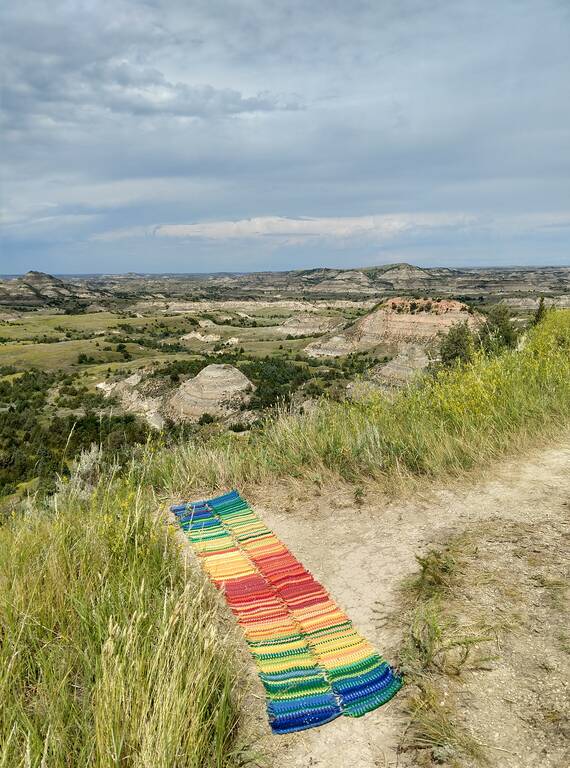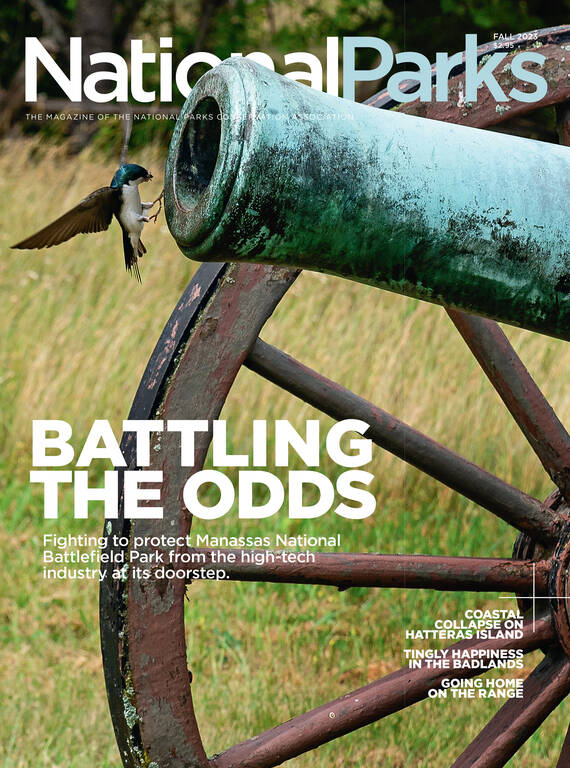Fall 2023
A Stitch in Time
Volunteer crafters use yarn to highlight climate change in national parks.
People have long associated colors with temperatures. The higher the thermometer climbs, the redder the hue on weather maps. By contrast, blues and purples pop to mind if we shiver in a cold breeze. In 2017, when a group of fiber artists sought a way to illustrate a changing climate, they turned to the color spectrum. With 365 rows and 32 shades of yarn they created a fuzzy way to materially show warming temperatures, calling the result a “tempestry.”
Picture a scarf, then divide the long rectangle into individual rows, one for each day of the year. Starting with January temperature data for a specific location, crafters — knitters, crocheters or weavers — use a color of yarn that represents the high temperature of each day as they build row upon row toward December. Each 5-degree increment, from a bone-chilling minus 30 degrees Fahrenheit to a blistering 121 degrees, is assigned its own unique hue. The outcome is a cozy, touchable bar graph.
The tempestry creators — Emily McNeil, Asy Connelly and Marissa Connelly — were inspired to record climate data in textiles for posterity, but also to provide a new window into what can be a complicated topic for those who do not relish poring over scientific reports. McNeil and Marissa Connelly bring the knitting expertise (McNeil managed a yarn shop in Washington before moving to New York), while Asy Connelly is the data guru, connecting the team with National Oceanic and Atmospheric Administration information.
The trio founded a business — The Tempestry Project — to provide kits for crafters interested in creating their own tempestry, with premeasured colored yarn and data printed in neat rows. Their first year, they sold 40 kits. By 2018, it was 500. Now, they routinely sell hundreds of kits per year.
Ironically, I am one of those people who like to pore over weather data. My career revolves around effectively communicating science to the public, plus I’m the daughter of a climate scientist, so I’ve seen firsthand how inaccessible the subject can be for the people most impacted. When I tried my hand at a tempestry (after stumbling across the business online), I fell in love with the process from the very first stitch. The ease of immersing myself in data appealed to both my scientist and fiber artist sides.

These tempestries, or temperature tapestries, illustrate the daily highs at Theodore Roosevelt National Park in 1916 (left) and 2016 (right).
PHOTO COURTESY OF KATHLEEN RODERICKI knitted in the evenings for weeks to finish my first tempestry, which showcased the White Mountains of New Hampshire, where my mom works. Soon after, I purchased a tempestry representing Gulf Islands National Seashore for my great-aunt. That got me thinking: I wished I could see tempestries for Acadia, Everglades and Grand Canyon national parks, as well as the dozens of other national park sites that have shaped my outlook on the natural world.
I wondered whether a tempestry collection focused on climate change in our national parks would be a compelling way to make the crisis real for people. Soon enough, I landed on an ambitious goal: to inspire a community of park-loving crafters to make tempestries for at least 50 national parks, either those closest to their hearts or parks that they wanted to visit someday. Critically, each park would have two tempestries, one from 2016 (the year of the Park Service centennial) and one from a time in the past, such as 1916 or 1966. Once completed, each pair would be photographed in its national park setting to juxtapose the weather data with the landscape itself.
The Tempestry Project team posted a call for volunteers on social media, and I wrote about the initiative for National Parks Traveler in April of 2019. Karen Templer, a crafting influencer, picked up the story and shared it with her blog followers, hailing the project as “data-nerdery in knitted form.” Volunteers immediately started rolling in, and I directed the effort, from coordinating the kit orders to arranging the photography. The tempestries proved to be a labor of love that often took months. If crafters couldn’t photograph their yarn creations in the park they represented, they shipped the tempestries across the country to volunteer photographers or Park Service staff.
From start to finish, the process unfolded over more than three years, with a government shutdown (which temporarily barred access to the weather data) and a pandemic in between. Today, the national park tempestries — representing more than 50 sites as planned — have been displayed in parks, libraries and bookstores in half a dozen states, with more exhibits in the works. To my delight, I even had the chance to turn the collection into a book, which came out in the summer of 2022.

How the Climate Crisis Is Affecting National Parks
Climate change is the greatest threat the national parks have ever faced. Nearly everything we know and love about the parks — their plants and animals, rivers and lakes, glaciers,…
See more ›The power of the project centers around the crafters’ tactile connection to the data and the ability to compare then-and-now temperature patterns at a glance. Looking at the crocheted tempestries for Theodore Roosevelt National Park in North Dakota, for example, summer heat waves extend literal inches longer in the one for 2016 than the one for 1916. Compare that with the tempestries for Voyageurs National Park, Minnesota, which show higher peak temperatures in 1975, but an overall warmer spring, summer and fall in 2016.
Put simply, these handcrafted graphs are approachable. I set up a small exhibit in my local library, using 12 tempestries to represent six locations. Before I had finished carefully laying out the fiber pieces, a woman and her teenage son approached with a friendly wave. I explained how to make tempestries, then pointed to the Point Reyes National Seashore pair. Right beneath my fingers I could show them how 2016 had a warmer spring and fall compared with 1966. Then I flipped to Point Reyes in the book and showed them a photo of one of the tempestries in front of the seashore’s dramatic Californian coastline. They left the library intent on researching tempestries and climate change online. This is precisely the sort of exchange I’d hoped the project would spark.
“While knitting and photographing for this project, the tempestries provided a visible and tangible entry point for friends, family members and even strangers into a conversation about climate change,” said California-based Stephanie Panlasigui. Panlasigui not only knit the Glacier National Park tempestries, she also photographed others’ work in a few of the parks in her state, including Yosemite National Park and Golden Gate National Recreation Area. She explained the project, her fingers flying with two needles and yarn, to acquaintances, fellow patients in a doctor’s office waiting room and colleagues while on work trips.

National Parks
You can read this and other stories about history, nature, culture, art, conservation, travel, science and more in National Parks magazine. Your tax-deductible membership donation of $25 or more entitles…
See more ›The Tempestry Project team said they were surprised by how emotional the park collection proved to be. “We’ve seen people slowly paging through the book and abruptly stop, hand over mouth, looking deeply at a picture that caught their eye — perhaps of a park they visited as a child, or took their children to, or even got married in,” the founders wrote in an email.
The National Parks Tempestry Project gave me hope on days when coverage of environmental catastrophes felt overwhelming. So many people contributed their time and crafting expertise to create tempestries and push the climate change conversation forward. Our work doesn’t live in academic journals, nor is it reliant on news cycles or social media impressions. It lives in our homes, at our fingertips, in our personal exchanges with family and friends. Each person we reach is one more voice that can encourage climate action, strengthening the movement for a more resilient future for our parks and our communities.




